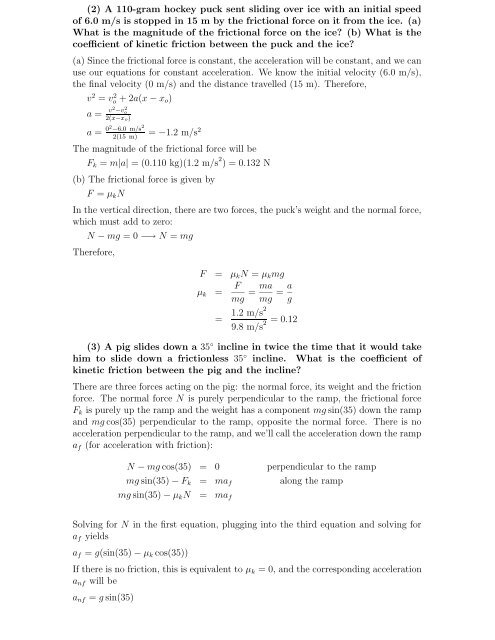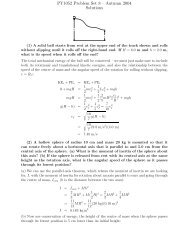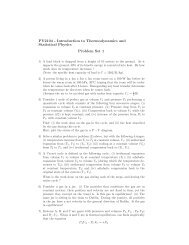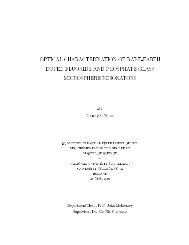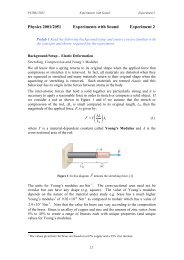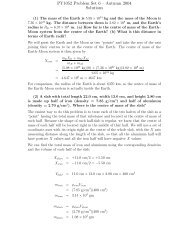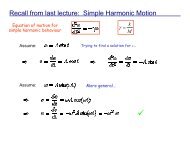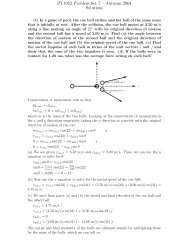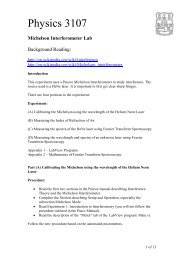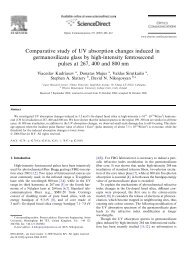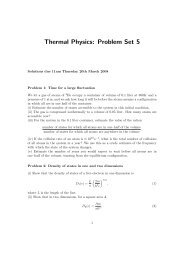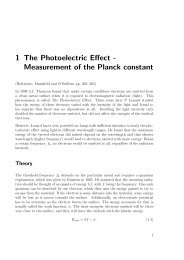PY1052 Problem Set 3 â Autumn 2004 Solutions
PY1052 Problem Set 3 â Autumn 2004 Solutions
PY1052 Problem Set 3 â Autumn 2004 Solutions
Create successful ePaper yourself
Turn your PDF publications into a flip-book with our unique Google optimized e-Paper software.
(2) A 110-gram hockey puck sent sliding over ice with an initial speedof 6.0 m/s is stopped in 15 m by the frictional force on it from the ice. (a)What is the magnitude of the frictional force on the ice? (b) What is thecoefficient of kinetic friction between the puck and the ice?(a) Since the frictional force is constant, the acceleration will be constant, and we canuse our equations for constant acceleration. We know the initial velocity (6.0 m/s),the final velocity (0 m/s) and the distance travelled (15 m). Therefore,v 2 = v 2 o + 2a(x − x o )a = v2 −v 2 o2(x−x o)a = 02 −6.0 m/s 22(15 m)= −1.2 m/s 2The magnitude of the frictional force will beF k = m|a| = (0.110 kg)(1.2 m/s 2 ) = 0.132 N(b) The frictional force is given byF = µ k NIn the vertical direction, there are two forces, the puck’s weight and the normal force,which must add to zero:N − mg = 0 −→ N = mgTherefore,F = µ k N = µ k mgµ k = F mg = mamg = a g=1.2 m/s29.8 m/s 2 = 0.12(3) A pig slides down a 35 ◦ incline in twice the time that it would takehim to slide down a frictionless 35 ◦ incline. What is the coefficient ofkinetic friction between the pig and the incline?There are three forces acting on the pig: the normal force, its weight and the frictionforce. The normal force N is purely perpendicular to the ramp, the frictional forceF k is purely up the ramp and the weight has a component mg sin(35) down the rampand mg cos(35) perpendicular to the ramp, opposite the normal force. There is noacceleration perpendicular to the ramp, and we’ll call the acceleration down the rampa f (for acceleration with friction):N − mg cos(35) = 0 perpendicular to the rampmg sin(35) − F k = ma f along the rampmg sin(35) − µ k N = ma fSolving for N in the first equation, plugging into the third equation and solving fora f yieldsa f = g(sin(35) − µ k cos(35))If there is no friction, this is equivalent to µ k = 0, and the corresponding accelerationa nf will bea nf = g sin(35)


